
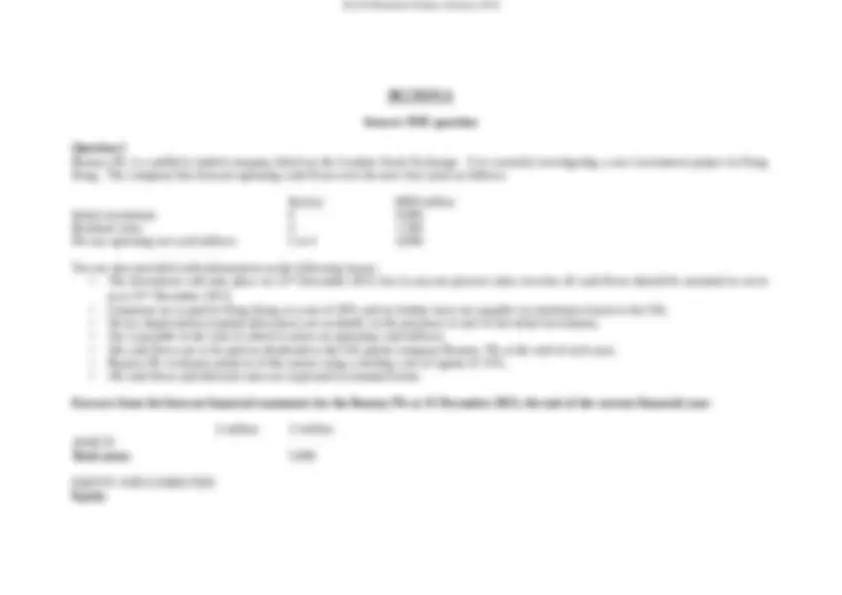
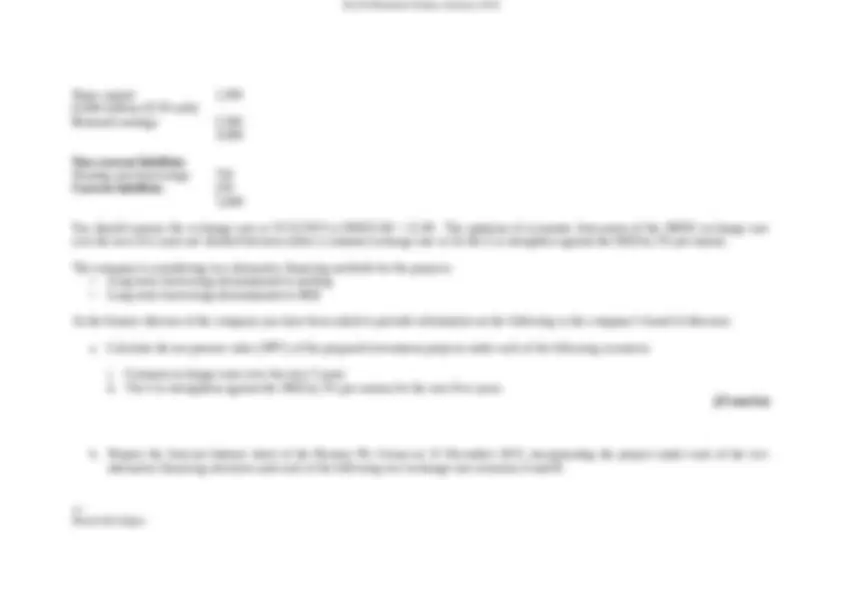
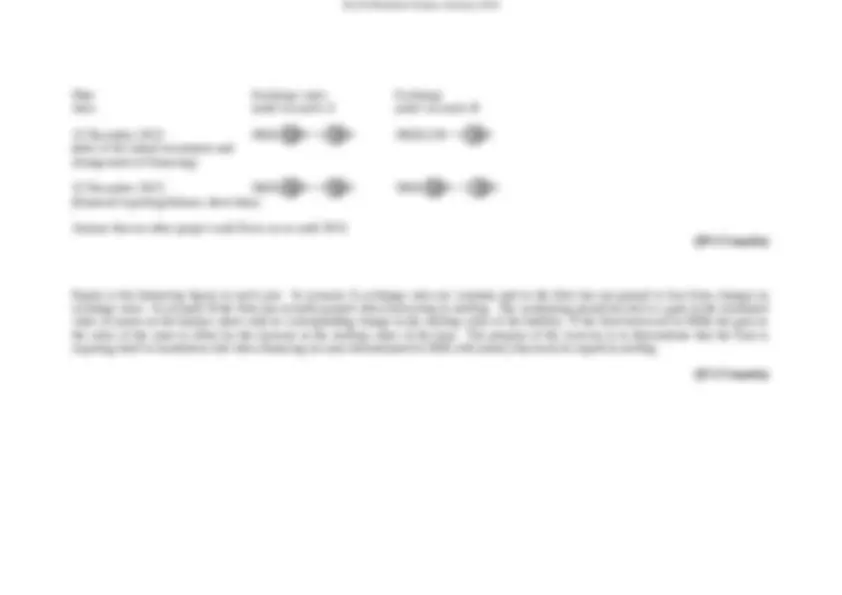
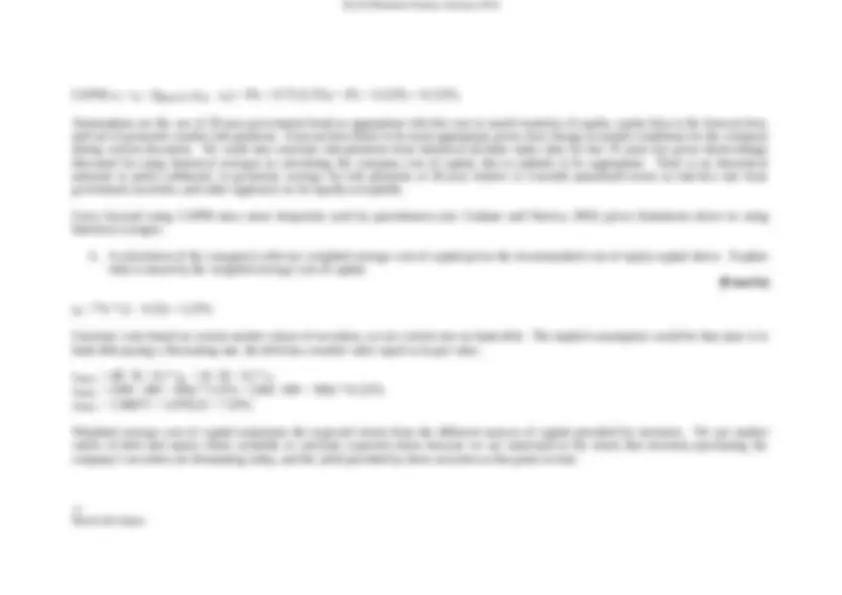
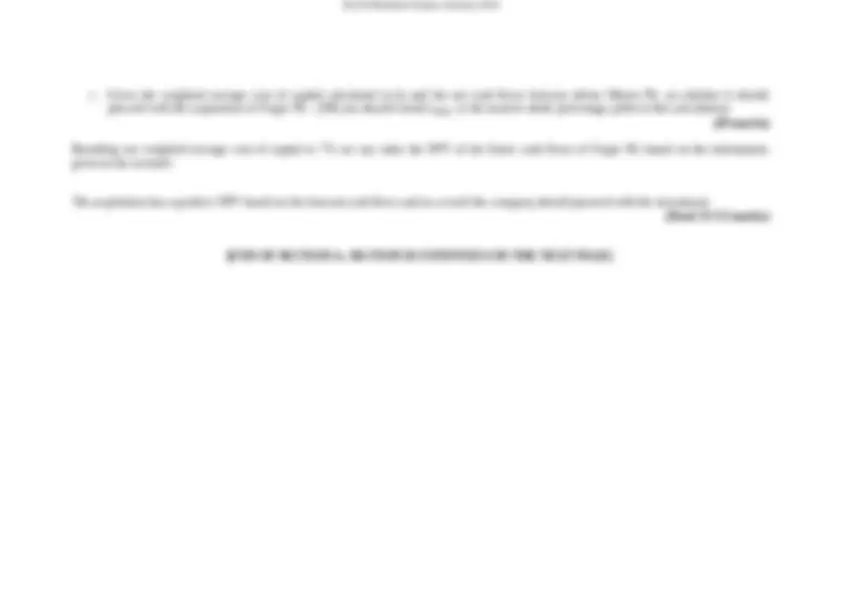
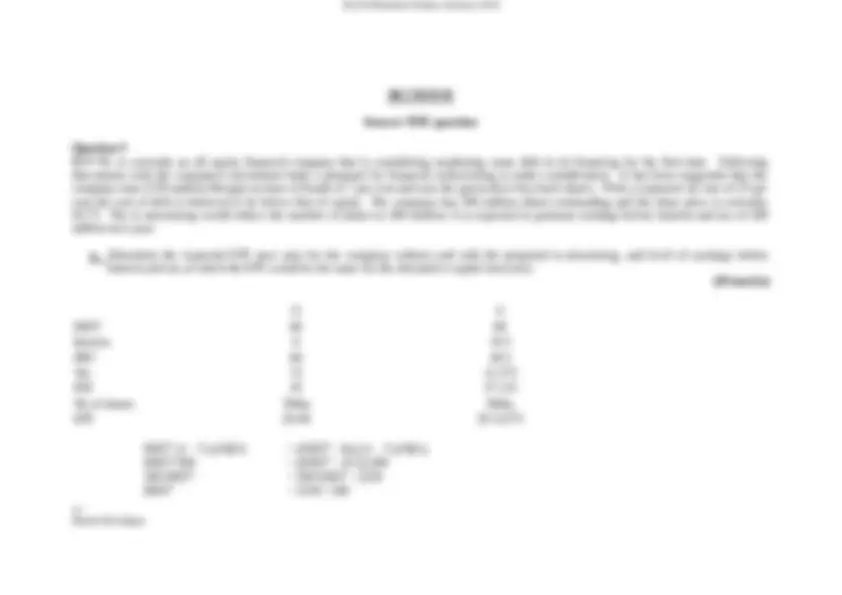
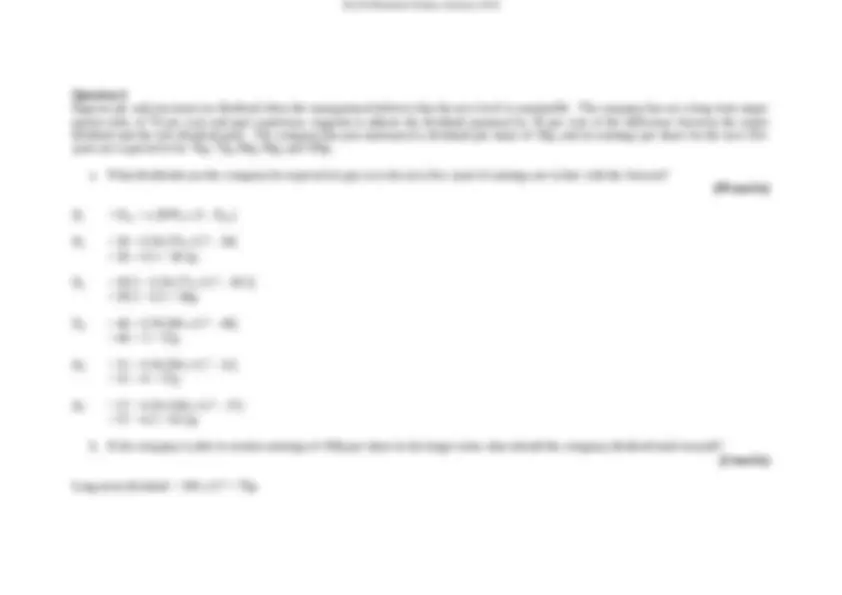
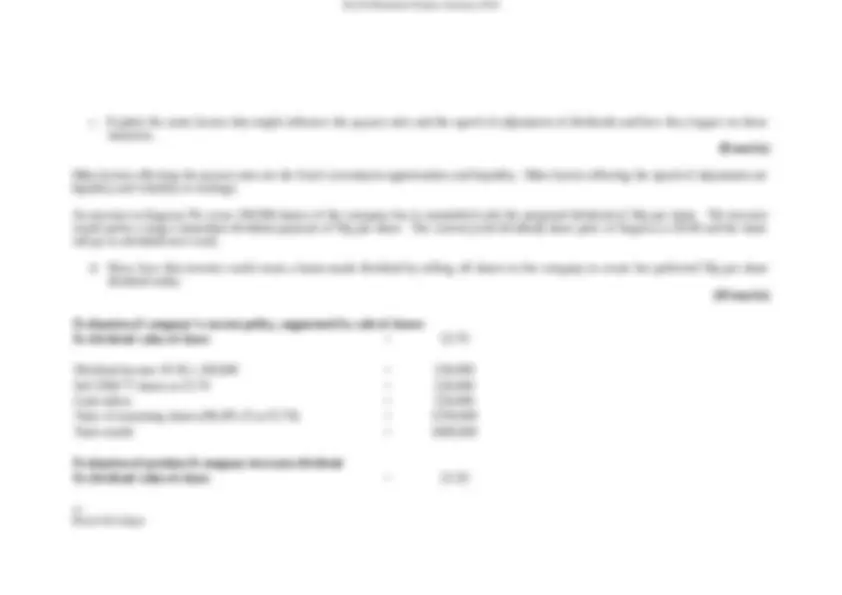

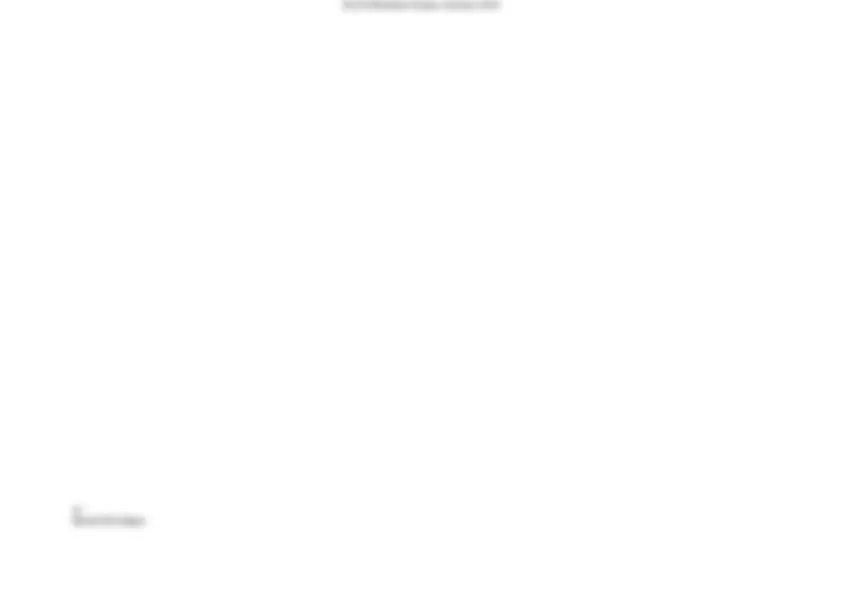
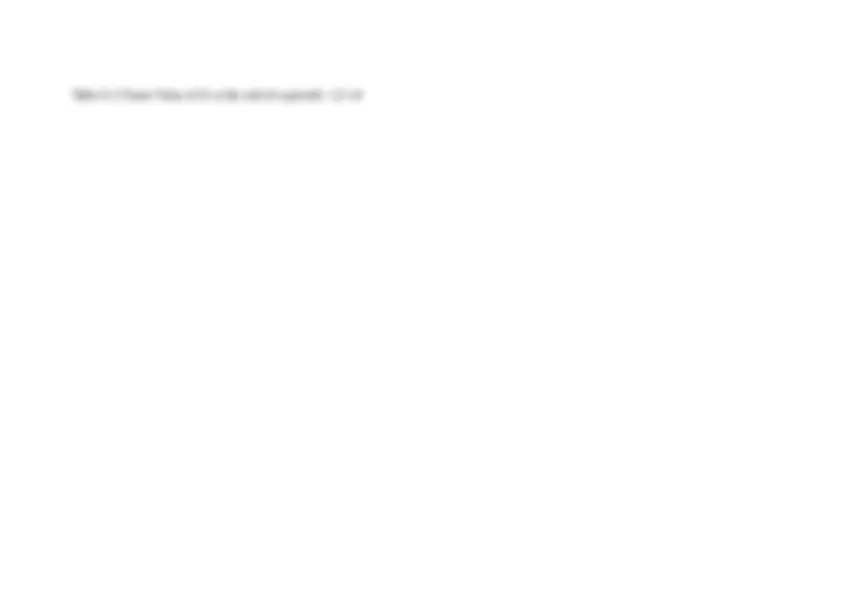
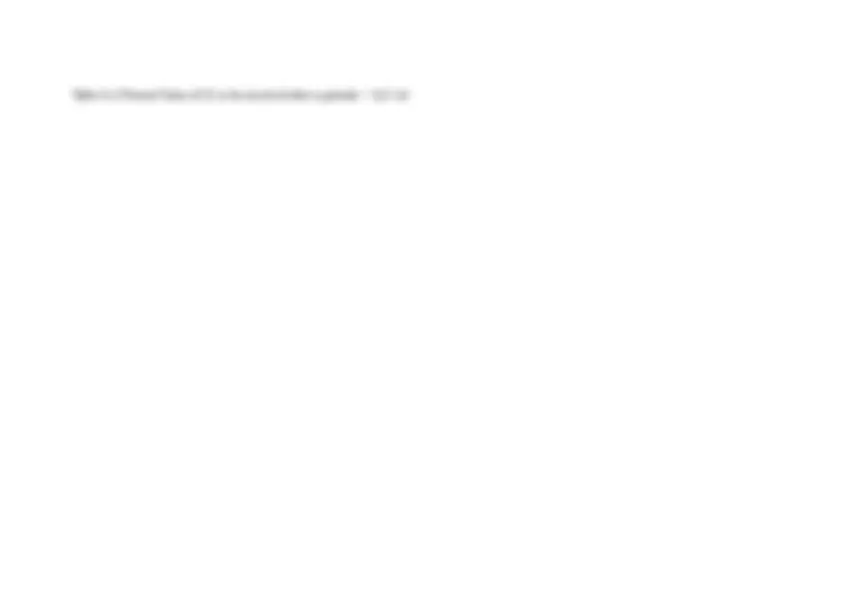
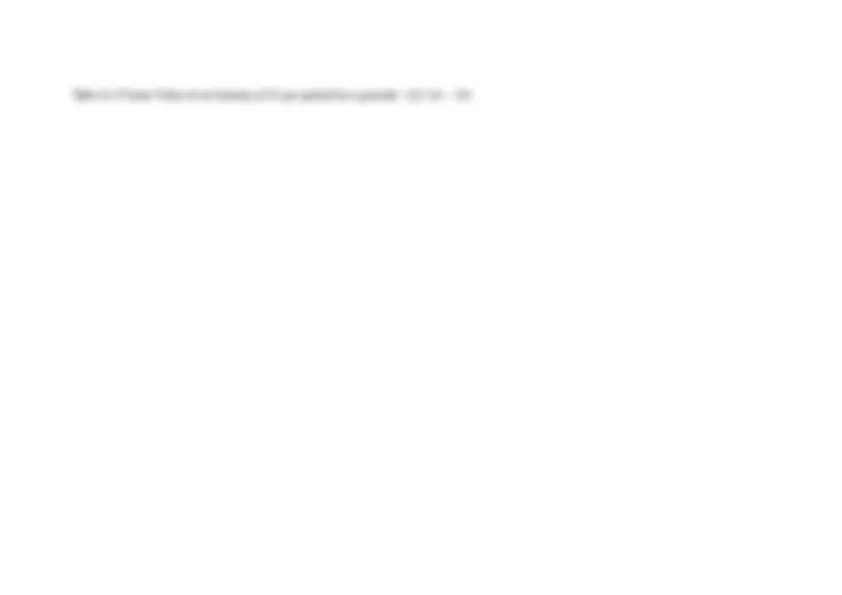
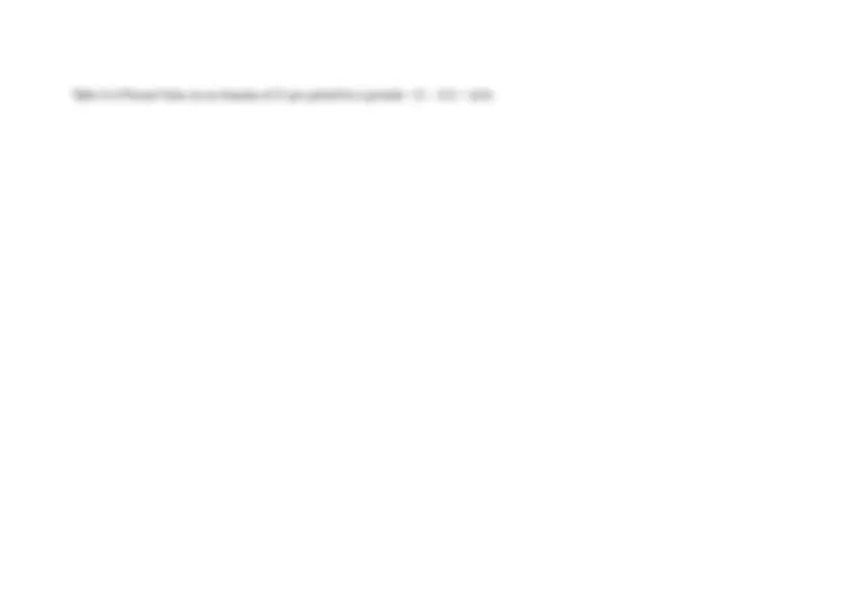


Study with the several resources on Docsity

Earn points by helping other students or get them with a premium plan


Prepare for your exams
Study with the several resources on Docsity

Earn points to download
Earn points by helping other students or get them with a premium plan
Community
Ask the community for help and clear up your study doubts
Discover the best universities in your country according to Docsity users
Free resources
Download our free guides on studying techniques, anxiety management strategies, and thesis advice from Docsity tutors
Information for a business finance exam focusing on calculating the cost of capital for a company and evaluating an acquisition. The exam includes three sections with questions related to net present value calculations, determining expected earnings per share, and explaining the role of personal taxation in limiting corporate tax benefits. The document also includes exchange rates and financial data for rooney plc and moyes plc.
Typology: Exercises
1 / 22

This page cannot be seen from the preview
Don't miss anything!















Calculators must not be used to store text and/or formulae nor be capable of communication. Invigilators may require calculators to be reset
12 Patrick McColgan
Share capital 1, (3,000 million £0.50 ords) Retained earnings 2, 4,
Non-current liabilities Floating rate borrowings 750 Current liabilities 250 5,
You should assume the exchange rate at 31/12/2013 is HK$12.00 = £1.00. The opinions of economic forecasters of the HK$/£ exchange rate over the next five years are divided between either a constant exchange rate or for the £ to strengthen against the HK$ by 3% per annum.
The company is considering two alternative financing methods for the projects:
As the finance director of the company you have been asked to provide information on the following to the company’s board of directors:
a. Calculate the net present value (NPV) of the proposed investment projects under each of the following scenarios:
i. Constant exchange rates over the next 5 years ii. The £ to strengthens against the HK$ by 3% per annum for the next five years. (23 marks)
b. Prepare the forecast balance sheet of the Rooney Plc Group on 31 December 2013, incorporating the project under each of the two alternative financing structures and each of the following two exchange rate scenarios A and B:
12 Patrick McColgan
Date Exchange rates Exchange rates under scenario A under scenario B
15 December 2013 HK$122 2C 5 00 = £12 2C 5 00 HK$12.00 = £12 2C 5 00 (date of the initial investment and arrangement of financing)
31 December 2013 HK$122 2C 5 00 = £12 2C 5 00 HK$112 2C 5 00 = £12 2C 5 00 (financial reporting/balance sheet date)
Assume that no other project cash flows occur until 2014. (10 1/3 marks)
Equity is the balancing figure in each case. In scenario A exchange rates are constant and so the firm has not gained or lost from changes in exchange rates. In scenario B the firm has actually gained when borrowing in sterling. The weakening pound has led to a gain in the translated value of assets on the balance sheet with no corresponding change in the sterling value of the liability. If the firm borrowed in HK$s the gain in the value of the asset is offset by the increase in the sterling value of the loan. The purpose of the exercise is to demonstrate that the firm is exposing itself to translation risk when financing an asset denominated in HK$ with money that must be repaid in sterling.
(33 1/3 marks)
Company Equity Beta 2010 0. 2011 0. 2012 1. 2013 1. Forecast 2014 0.
The acquisition will be financed by a combination of debt and equity in order to maintain the existing capital structure of the business. Prior to the acquisition, Moyes Plc has bank borrowings with a value of £300million outstanding. The company pays interest based on LIBOR + 5%. Annualised 3-month LIBOR is currently 2.00%. The company expects to pay tax on the net cash flows of the acquired company at a marginal rate of 25%. The firm’s equity has a market value of £500million today.
As the finance director of the company you have been asked to provide information on the following to the company’s board of directors:
a. A recommendation as to the appropriate cost of equity capital for the company. Your discussion should cover a range of methods based on the data provided above, the relative strengths and weakness of each method available, and you should conclude with a recommendation as to the most appropriate cost of equity capital for the company and justify your choice. (15 1/3 marks)
Given data provided only historical averages and CAPM are available. There is no information on earnings or dividends that would allow the use of DCF methods.
Moyes Plc arithmetic mean 2004-2013: 3.20% Moyes Plc geometric mean 2004-2013: 0.29%
Approach relies on past performance being repeated in the future, which is unlikely is markets are efficient and the companies have changed over time. The expected return on equity using these approaches is close to the long-term government bond yield, highlighting the weakness of this method.
CAPM: rS = r (^) F + βEQUITY (r (^) M – r (^) F ) = 4% + 0.75 (5.5%) = 4% + 4.125% = 8.125%
Assumptions are the use of 20-year government bond as appropriate risk-free rate to match maturity of equity; equity beta is the forecast beta, and use of geometric market risk premium. Forecast beta likely to be most appropriate given clear change in market conditions for the company during current downturn. We could also calculate risk-premium from historical all-share index data for last 10 years but given shortcomings discussed for using historical averages in calculating the company cost of capital, this is unlikely to be appropriate. There is no theoretical rationale to prefer arithmetic or geometric average for risk premium or 20-year relative to 3-month annualised return as risk-free rate from government securities, and either approach we be equally acceptable.
Carry forward using CAPM since most frequently used by practitioners (see Graham and Harvey, 2001) given limitations above in using historical averages.
b. A calculation of the company’s after-tax weighted average cost of capital given the recommended cost of equity capital above. Explain what is meant by the weighted average cost of capital. (8 marks)
r (^) B = 7% * (1 – 0.25) = 5.25%
Calculate costs based on current market values of securities, so use current rate on bank debt. The implicit assumption would be that since it is bank debt paying a fluctuating rate, the debt has a market value equal to its par value.
r (^) WACC = (B / B + S) * rB + (S / B + S) * rS r (^) WACC = (300 / 300 + 500) * 5.25% + (500 / 300 + 500) * 8.125%
r (^) WACC = 1.96875 + 5.078125 = 7.05%
Weighted average cost of capital represents the expected return from the different sources of capital provided by investors. We use market values of debt and equity where available to calculate expected return because we are interested in the return that investors purchasing the company’s securities are demanding today, and the yield provided by these securities at that point in time.
12 Patrick McColgan
Answer ONE question
Question 3 RVP Plc is currently an all equity financed company that is considering employing some debt in its financing for the first time. Following discussions with the company's investment bank a proposal for financial restructuring is under consideration. It has been suggested that the company raise £150 million through an issue of bonds at 7 per cent and uses the proceeds to buy back shares. With a corporate tax rate of 25 per cent the cost of debt is believed to be below that of equity. The company has 500 million shares outstanding and the share price is currently £0.75. The re-structuring would reduce the number of shares to 300 million. It is expected to generate earnings before interest and tax of £ million next year.
a. Determine the expected EPS next year for the company without and with the proposed re-structuring, and level of earnings before interest and tax at which the EPS would be the same for the alternative capital structures. (10 marks)
Interest 0 10. PBT 60 49. Tax 15 12. PAT 45 37. No of shares 500m 300m EPS £0.09 £0.
EBIT^ (1 – Tc )/(N(U) = (EBIT^ - Int) (1 – T (^) c)/N(G) EBIT/500 = (EBIT^ - 10.5)/ 300 EBIT^ = 500 EBIT^ - 5250 EBIT*^ = 5250 / 200
12 Patrick McColgan
EBIT*^ = 26.25m EPS = £26.25m * (1 – 0.25) / 500million = £0. EPS = (26.25 - £10.5m) * (1 – 0.25) / 300million = £0.
Assuming that earnings before interest in taxes of £60 million will be generated in perpetuity. Given this, calculate the following:
b. What is the (ungeared) cost of equity capital prior to the financial restructuring? (3 marks)
r 0 = £60m x (1 – 0.25) / £375 million = 0.
c. What is the market value of RVP plc’s equity and the overall value of the firm following the financial restructuring? (4 marks)
VG = VU + T (^) CB (^) G = £375million + 0.25*£150m = £412.5million SG = VG – B (^) G = £412.5million - £150million = £262.5million
d. What is the geared cost of equity capital for RVP plc following the financial restructuring? (3 marks)
r (^) S = r 0 + ((r 0 – r (^) B) x (1 – TC) x (B (^) G /S (^) G )) r (^) S = 0.12 + ((0.12 – 0.07) x (1 – 0.25) x (150/262.5)) r (^) S = 14.14%
e. What is the firm’s weighted average cost of capital following the restructuring? (3 marks)
r (^) WACC = (SG /V (^) G ) x r (^) S + (B (^) G /S (^) G ) x r (^) B x (1 – TC) = 0. r (^) WACC = (262.5/412.5) x 0.1414 + (150/412.5) x 0.07 x (1 – 0.25) r (^) WACC = 10.91%
Question 4 Kagawa plc only increases its dividend when the management believes that the new level is sustainable. The company has set a long term target payout ratio of 70 per cent and past experience suggests it adjusts the dividend payment by 50 per cent of the difference between the target dividend and the last dividend paid. The company has just announced a dividend per share of 30p, and its earnings per share for the next five years are expected to be 70p, 75p, 80p, 90p, and 100p.
a. What dividends can the company be expected to pay over the next five years if earnings are in line with the forecast? (10 marks)
Dt = Dt-1 + a [EPS (^) t x Z – D (^) t-1 ]
D 1 = 30 + 0.50 [70 x 0.7 – 30]
= 30 + 9.5 = 39.5p
D 2 = 39.5 + 0.50 [75 x 0.7 – 39.5] = 39.5 + 6.5 = 46p
D 3 = 46 + 0.50 [80 x 0.7 – 46] = 46 + 5 = 51p
D 4 = 51 + 0.50 [90 x 0.7 – 51] = 51 + 6 = 57p
D 5 = 57 + 0.50 [100 x 0.7 – 57] = 57 + 6.5 = 63.5p
b. If the company is able to sustain earnings of 100p per share in the longer term what should the company dividend tend towards? (2 marks)
Long-term dividend = 100 x 0.7 = 70p
c. Explain the main factors that might influence the payout ratio and the speed of adjustment of dividends and how they impact on these measures. (8 marks)
Main factors affecting the payout ratio are the firm’s investment opportunities and liquidity. Main factors affecting the speed of adjustment are liquidity and volatility or earnings.
An investor in Kagawa Plc owns 100,000 shares of the company but is unsatisfied with the proposed dividend of 30p per share. The investor would prefer a larger immediate dividend payment of 50p per share. The current (with dividend) share price of Kagawa is £6.00 and the share will go ex-dividend next week.
d. Show how this investor could create a home-made dividend by selling off shares in the company to create her preferred 50p per share dividend today. (10 marks)
Evaluation of company’s current policy, augmented by sale of shares Ex dividend value of share = £5.
Dividend income £0.30 x 100,000 = £30, Sell 3508.77 shares at £5.70 = £20, Cash inflow = £50, Value of remaining shares (96,491.23 at £5.70) = £550, Total wealth = £600,
Evaluation of position if company increases dividend Ex dividend value of share = £5.
12 Patrick McColgan
Answer ONE question
Question 5 Explain what is meant by aggressive and conservative working capital management policies and the main costs and benefits of these two approaches. (33 1/3 marks)
Aggressive policy involves low current assets relative to current liabilities. Advantage is lower interest cost on debt as assets are financed by non-interest bearing current liabilities. Cost of this strategy is risk of insolvency, possibility of stock-outs through low inventory balances, less generous credit terms from suppliers given delays in paying, and possibility of lower quality suppliers being the only ones to agree to credit terms. Conservative policy is high current assets relative to current liabilities. Advantages are greater flexibility to deal with inventory delivery problems and an accounts receivable policy that could lead to higher sales. Main cost is higher interest charges to finance higher current asset balances.
Question 6 Explain the main mechanisms for raising capital through a seasoned equity offering (SEO) for UK companies. Your discussion should include specific reference to the factors that affect the choice of issue method and the impact the different issue methods should be expected to have on existing shareholder wealth. (33 1/3 marks)
The main issue methods are rights offers, placings, open offers, and combination open offers and placings. Mention could also be made to vendor placings and bought deals, although these tend to be less important in economic terms, and share financed acquisitions. Non-rights preserving methods are often said to dilute existing shareholder wealth because they are not able to participate in purchasing new shares at a discount to the current market price. In a rights offer this effect compensates for the reduction in the price of existing shares to the TERP. Given this dilution, non-rights preserving issues are limited in the amounts of capital they can raise and the subscription price discount to the current market price.
[END OF PAPER]
12 Patrick McColgan
Table A-1 Future Value of £1 at the end of n periods = (1+r)n
Table A-2 Present Value of £1 to be received after n periods = 1/(1+r)n